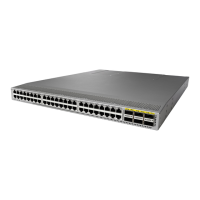Send document comments to nexus3k-docfeedback@cisco.com
9-9
Cisco Nexus 3000 Series NX-OS Unicast Routing Configuration Guide, NX-OS Release5.0(3)U1(1)
Chapter 9 Configuring Layer 3 Virtualization
Configuring VRFs
This example shows how to add an interface to the VRF:
switch# configure terminal
switch(config)# interface ethernet 1/2
switch(config-if)# vrf member RemoteOfficeVRF
switch(config-if)# ip address 192.0.2.1/16
switch(config-if)# copy running-config startup-config
Configuring VRF Parameters for a Routing Protocol
You can associate a routing protocol with one or more VRFs. See the appropriate chapter for information
on how to configure VRFs for the routing protocol. This section uses OSPFv2 as an example protocol
for the detailed configuration steps.
SUMMARY STEPS
1. configure terminal
2. router ospf instance-tag
3. vrf vrf-name
4. (Optional) maximum-paths paths
5. interface interface-type slot/port
6. vrf member vrf-name
7. ip address ip-prefix/length
8. ip router ospf instance-tag area area-id
9. (Optional) copy running-config startup-config
DETAILED STEPS
Command Purpose
Step 1
configure terminal
Example:
switch# configure terminal
switch(config)#
Enters configuration mode.
Step 2
router ospf
instance-tag
Example:
switch(config-vrf)# router ospf 201
switch(config-router)#
Creates a new OSPFv2 instance with the configured
instance tag.
Step 3
vrf
vrf-name
Example:
switch(config-router)# vrf
RemoteOfficeVRF
switch(config-router-vrf)#
Enters VRF configuration mode.

